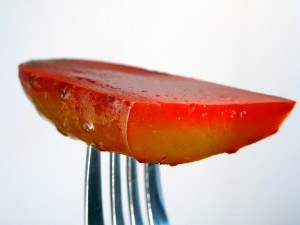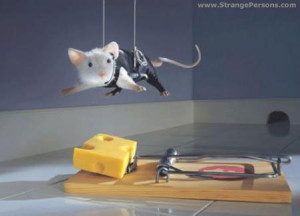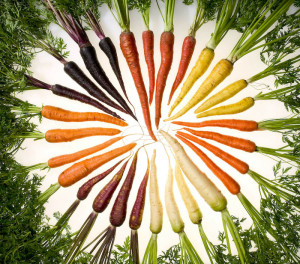By: Amelia Chen
At our IFTSA area meeting, all we had to say was that we were in town for a food trivia competition for the hotel concierge to chuckle and overlook their policy for having a credit card on file for damages. It’s a pretty accurate response when I tell people that’s what I do in my spare time. Though we affectionately call it “Nerd Competition,” College Bowl is more than memorizing technical terms and equations. As intense as you’d imagine a group of young adults with buzzers can get, my most memorable moments from this past year of learning everything from Boyle’s Law to tequila production are when we veered away from the hard science.
So in honor of the fast approaching IFT 2015 meeting and Official Food Geek antics to come, UW-Madison’s College Bowl team would like to share some of their random favorite food fun facts.
1. Fruit Loops are all the same flavor. Source.
I’m not going to try to hide my disappointment and slight embarrassment about this news. It was a habit of mine to always shun the red and orange flavors in favor of green and blue ones because I was more partial to the limes and blue raspberries of the candy world. Apparently, all my efforts of first eating my least favorite colors to save the best for last were for naught.

(source: www.ibelieveicanfry.com)
2. Koolickles is a food product that is pickles soaked in Kool-Aid. Source.
As beautiful as a line of jars of rainbow pickles would look against a clean white background, my tastebuds initially had a difficult time imagining enjoying a cherry flavored sweet pickle. But on second thought, I’ve had pickled papaya, pickled rhubarb, and pickled cherries…koolickles is basically the inverse. And suddenly it doesn’t seem so strange.
3. Pound cake got its name from its original recipe, which called for a pound each of butter, eggs, sugar, and flour. Source.
My only question here is: would this have caught on if it was invented by someone using the metric system?
4. An average ear of corn has an even number of rows – usually 16. Source.
Given a normal environment, the first kernel splits into two. I’m picturing one of those cool time lapsed developmental biology videos of frog or chicken embryos. Except we’re talking about corn. I always forget how complex plants are, which makes any new learned fact about them fascinating to me.
5. Chocolate was once used as currency. Source.
You’ve probably all heard of the ancient, lavish, and bitter drink “xocoatl.” So it’s not too much of a stretch to think people exchanged chocolate bars (or disks, with important faces carved into them) for goods – okay maybe not exactly like that, but you get it. It’s probably a good thing that my paycheck today is not directly edible because I don’t know how I’d manage to support myself after accidentally eating it all.
6. British sailors were called “Limeys” since they needed to travel with limes or their trees onboard to prevent scurvy. Source.
I want to say that the importance of vitamin C was taught early on in our education system. With that, I also want to say that I remember a lot of my friends pronouncing “scurvy” as if they were pirates, so now that’s the only thing my mind’s ear hears. Anyways, the British Royal Navy’s health improved after they started adding lime juice to their grog, but “Limeys” was historically used as a derogatory term by North Americans to eventually refer to any British person. So maybe try to refrain from throwing the word around in case someone’s still salty about the American Revolution.

(source: www.strangepersons.com)
7. Cheese is the most stolen food. Source.
If I wasn’t submersed in Wisconsin’s love for cheese right now, this would be a more surprising statistic. But even anywhere else, it makes sense. Cheese can be inconspicuously slipped into a bag and quickly disposed of after use. It’s not highly secured, but can be rather expensive. And most importantly, it tastes good. Disclaimer: we are in no way encouraging cheese theft.
8. The captain in Cap’n Crunch cereal is named Horatio Magellan Crunch. Source.
Now you can enjoy your bowl of cereal without the awkwardness of vaguely referring to Horatio as “you” when you need to address him, since it’s been too long in your relationship to ask for his name again, and no one else seems to know it either. You’re welcome.
9. The newest record for largest Rice Krispie’s treat is 11,327 pounds. Source.
I’m more than bummed that I missed the chance to see the entirety this monstrous thing, but it did taste pretty good for something that was produced in a 11k pound block. Whoever was involved in this should definitely be proud.

(source: www.aboutcarrots.weebly.com)
10. Carrots were originally purple. Source.
And possibly white. My first instinct is to ask why the orange carrot became the more desired variety. Did orange signify something special? Was it sweeter? Did it have some sort of magical antipesticide metabolic byproduct? Nah. Like most things, it was an accident – a genetic mutation. But the domestication of carrots did result in the sweet, smooth, and orange root we know and love to eat (with hummus) today.
Now, I encourage you all to leave a comment with your favorite food fun fact!
Cover Image: www.imagearcade.com






In honor of Leonard Nimoy, I can only comment, “Fascinating.”
I did find this sentence disturbingly evocative: “Cheese can be inconspicuously slipped into a bag and quickly disposed of after use.” The mind boggles.
re: #10, about carrots, perhaps the color was preferred? Norwegians refer to carrots as
gulrøtter, which literally would be “gold roots” in English. Admittedly this might be because of pricing – these days they can cost around 100 Norsk kroner per kg (about $16 US dollars), but then again, everything’s expensive in Norway except the snow.
Forgot to ask, where did you find the pickled rhubarb?
It was just as a garnish on a dessert, so it didn’t stand out too much in either a good or bad way. But hey, rhubarb is in season so you could make jars of it.